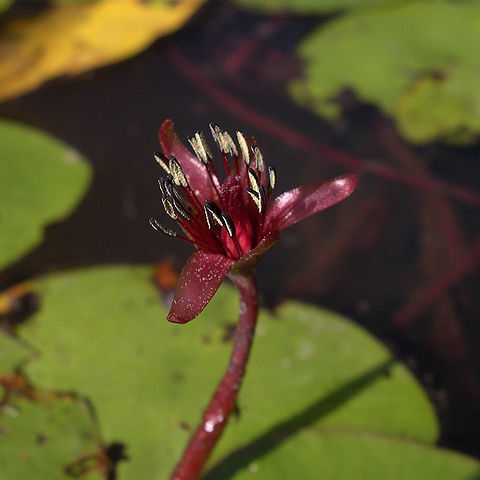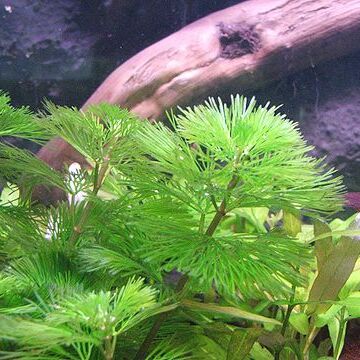Herbs perennial, aquatic. Stems slender, branched, rhizomatous, repent; internodes at first elongate and apically floating, later erect, foliate, and shortened. Leaves dimorphic. Submersed leaves (Cabomba only), opposite or sometimes whorled, palmately dissected. Floating leaves alternate, peltate, entire. Flowers solitary, axillary from distal nodes, short to long pedunculate, bisexual, hypogynous, actinomorphic, borne at or above water surface; perianth persistent. Sepals 3, separate or nearly so. Petals 3, distinct, alternating with sepals. Stamens 3--36(--51), anthers dehiscent by longitudinal slits. Pistils 3--18, simple, obclavate or ventricose. Ovary 1-loculed; ovules 1--3, pendulous. Styles short. Stigmas capitate or linear-decurrent. Fruit achenelike or folliclelike, coriaceous, indehiscent. Seed endosperm little, perisperm abundant; embryo minute; cotyledons 2, fleshy.
Perennial freshwater aquatic herbs with creeping stolons. Stems mucilaginous, at least when young. Leaves opposite, whorled or alternate; submerged leaves much dissected; floating leaves peltate. Flowers actinomorphic, bisexual, axillary or displaced from leaf axils, solitary, long pedunculate from upper nodes. Sepals 3, rarely 2 or 4, petaloid, free and distinct or nearly so. Petals 3, rarely 2 or 4. Stamens 3 or 6 (Cabomba) or usually 12–36 (Brasenia), free; anthers opening lengthwise; staminodes absent. Carpels 2–18, rarely 1, free, 1-locular; ovary superior; style short; ovules 2 or 3, rarely 1–5, anatropous. Fruits indehiscent, achene-like or follicle-like, 1–3-seeded. Seeds with fleshy endosperm.
Aquatic herbs with perennial sympodial rhizomes; stems long and slender, coated with mucilage. Leaves alternate, the floating ones peltate, the submerged ones finely divided or absent. Flowers rather small, hermaphrodite, axillary, solitary and regular. Sepals 3, petaloid. Petals 3, hypogynous. Stamens 3–18, with extrorse anthers dehiscing longitudinally. Carpels 2–18, completely free, with a simple narrow stigma but very reduced style; ovules 1–3, parietal, pendulous, anatropous. Fruiting carpels indehiscent, 1–3-seeded. Seeds with fleshy endosperm and perisperm but no aril
Carpels 2–18, free; style very short or absent but with an attenuated, entire stigma; ovules 1–3, pendulous, parietal
Leaves alternate, floating leaves peltate, sometimes with finely dissected submerged leaves in addition
Aquatic herbs with perennial rhizomes; stems coated with mucilage
Stamens 3–18; anthers extrorse, opening lengthwise
Flowers axillary, solitary, actinomorphic
Seeds 1–3 with a fleshy endosperm
Fruiting carpels indehiscent
Petals 3, hypogynous
Sepals 3


